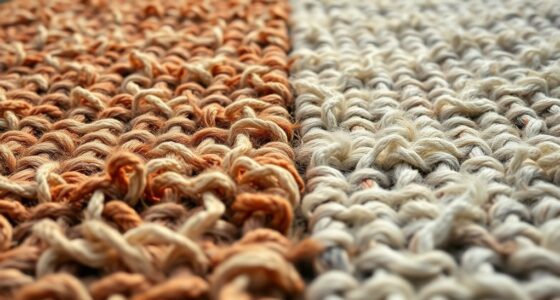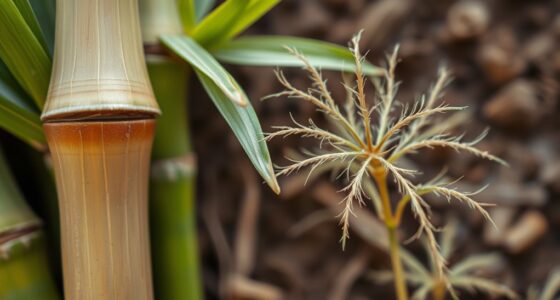Hemp and nettle fibers are excellent sustainable options for rugs, as they grow quickly with minimal water and chemicals. They’re durable, resistant to pests, and develop a natural patina over time. These fibers bring earthy tones and tactile warmth to your home, fitting styles like minimalist or bohemian. While they need careful maintenance, their eco-friendly production and biodegradability make them great alternatives to synthetic rugs. Explore more ways these natural fibers can transform your space and support sustainability.
Key Takeaways
- Hemp and nettle fibers are eco-friendly, biodegradable, and require minimal water and pesticides, reducing environmental impact.
- Both fibers are durable, resistant to pests and mold, and easy to maintain with simple cleaning methods.
- They offer natural earthy tones and tactile textures, fitting well into minimalist, bohemian, and Scandinavian decor styles.
- Processing involves eco-conscious methods, with increasing market availability and affordability driven by sustainable production.
- Challenges include less durability than synthetics and limited color options, but ongoing innovations aim to enhance their longevity and appeal.
The Environmental Benefits of Hemp and Nettle Fibers
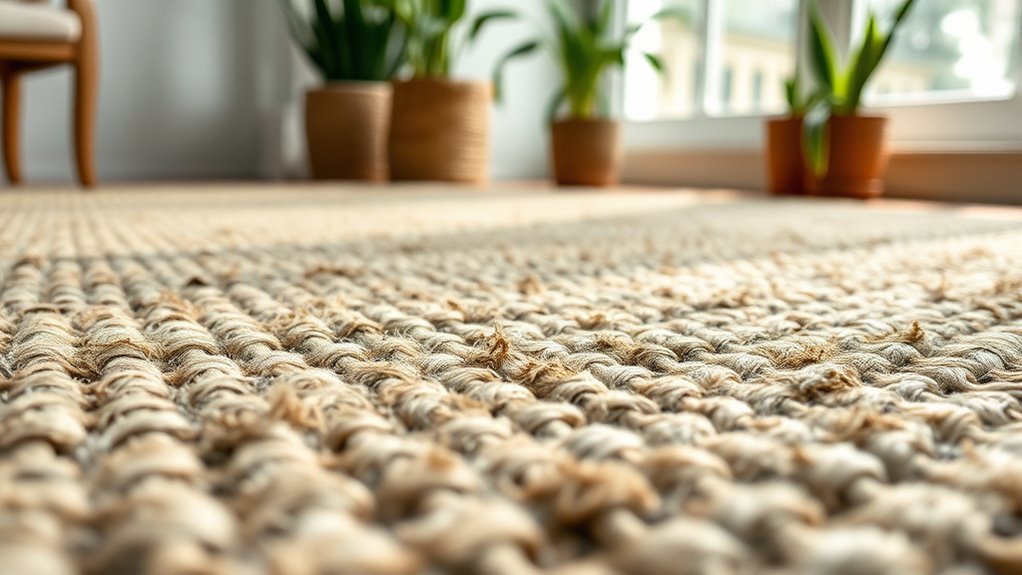
Hemp and nettle fibers offer significant environmental advantages compared to traditional rug materials. They grow quickly and require minimal water and pesticides, reducing their ecological footprint. Hemp, in particular, is a resilient crop that enriches the soil as it grows, meaning it often needs no chemical fertilizers. Nettle plants thrive naturally and can be harvested sustainably without damaging ecosystems. Both fibers are biodegradable, so they break down naturally at the end of their life cycle, unlike synthetic alternatives that persist in landfills. Their production consumes less energy, lowering greenhouse gas emissions. Choosing rugs made from hemp and nettle fibers helps you support eco-friendly practices, conserve resources, and reduce pollution, making them an excellent choice for environmentally conscious consumers.
Comparing Durability and Wear Resistance
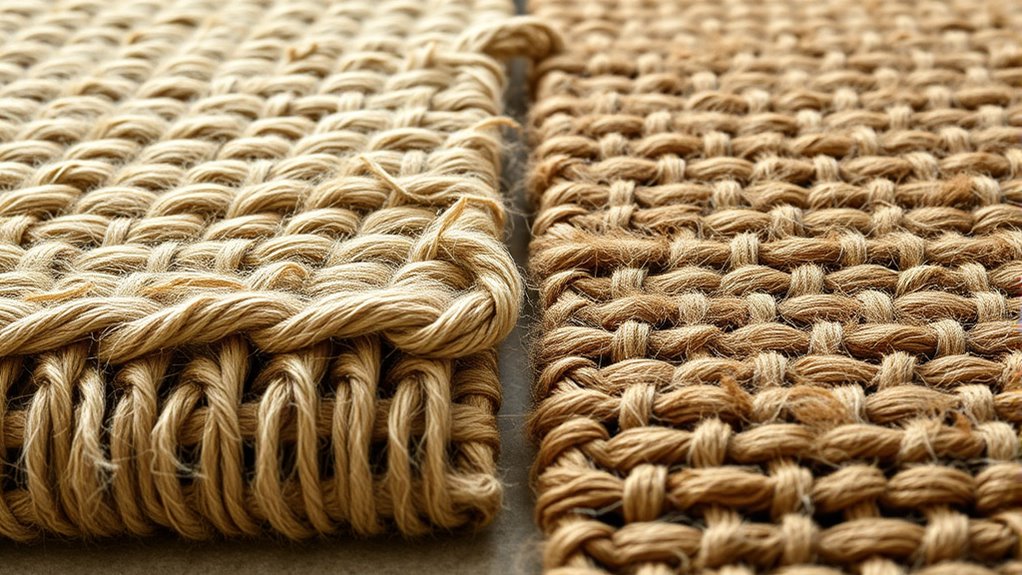
When choosing sustainable rugs, you’ll want to evaluate how well hemp stands up over time, thanks to its impressive longevity. Nettle fibers also offer resilience, making them a durable option for high-traffic areas. Comparing these materials helps you select the best option for both durability and eco-friendliness. Incorporating expert voice actors in promotional materials can further highlight the benefits of natural fibers like hemp and nettle.
Hemp Rug Longevity
Although hemp rugs are often praised for their eco-friendly qualities, their durability and wear resistance are equally impressive. You’ll find that hemp fibers are naturally tough, resisting crushing and heavy foot traffic over time. This strength means your rug can handle daily use without quickly showing signs of wear. Hemp’s natural resistance to dirt and moisture also helps retain its appearance longer, reducing the need for frequent cleaning or replacement. Additionally, hemp’s resilience and noise reduction technology contribute to its longevity by minimizing vibrations and wear from foot traffic. With proper care, a hemp rug can last for decades, making it a cost-effective choice in the long run. Its resilience ensures that it maintains its structural integrity, even in busy areas of your home. Overall, hemp’s longevity makes it an excellent sustainable choice for those seeking durability alongside environmental benefits.
Nettle Fiber Resilience
Nettle fiber stands out for its remarkable resilience, making it a strong contender among sustainable rug materials. Its natural strength and flexibility allow it to withstand daily wear and tear without quickly showing signs of damage. Nettle fibers resist pilling and maintain their appearance over time, even in high-traffic areas. Unlike some natural fibers that fray or break down, nettle fibers retain their integrity after repeated use. This durability means your rug will stay looking fresh longer, reducing the need for frequent replacements. Additionally, nettle’s inherent resistance to pests and mold adds to its longevity. Crochet styles can be used to further protect and enhance the appearance of nettle fiber rugs. Overall, nettle fiber’s resilience ensures your rug remains both functional and attractive, making it a smart, eco-friendly choice for long-term use.
Aesthetic Qualities and Design Flexibility
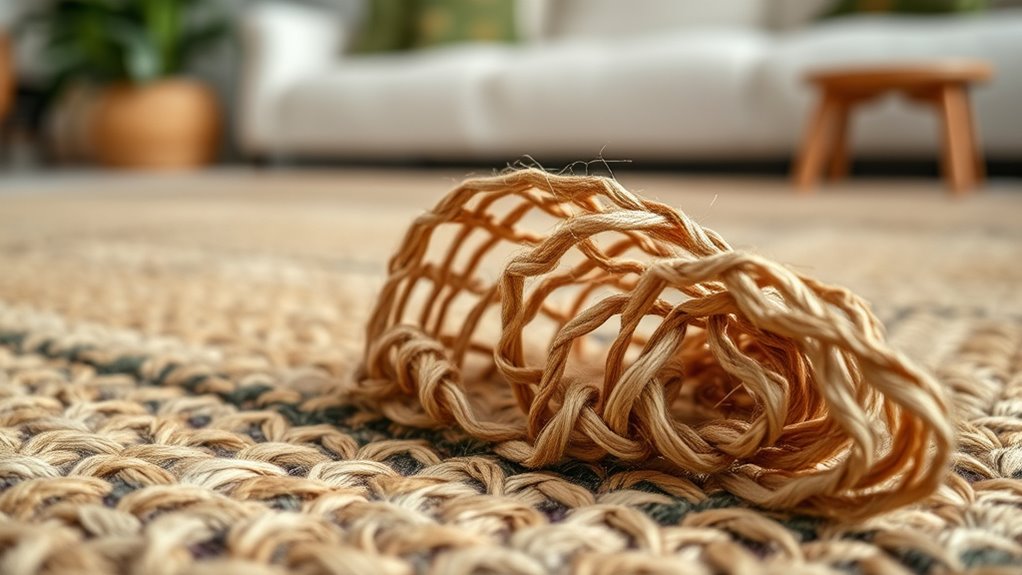
Sustainable rug materials offer a wide range of visual appeal and textures that can enhance any space. You’ll find they provide great design versatility, allowing for various patterns and styles that match your aesthetic. This flexibility makes it easier to create unique, attractive interiors that reflect your personal taste. Incorporating authentic antique pieces can further add character and charm to your decor, blending traditional elements with sustainable choices.
Visual Appeal and Texture
When choosing eco-friendly rug materials, you’ll find that their visual appeal and texture greatly influence your space’s overall aesthetic. Hemp and nettle fibres offer natural, earthy tones that enhance a cozy, organic look, blending well with various decor styles. Hemp’s coarse, slightly rugged texture adds a rustic charm, while nettle’s finer fibers provide a softer, more refined feel. Both materials develop a unique patina over time, adding character and depth to your rug. Their natural appearance can complement minimalist, bohemian, or Scandinavian interiors, giving your space an authentic, sustainable vibe. The textures invite touch, creating warmth and comfort underfoot. Additionally, the inherent durability of these fibres ensures your rug maintains its beauty over years of use. Overall, these fibres not only look appealing but also bring tactile richness that elevates your room’s aesthetic.
Design Versatility and Patterns
Eco-friendly rug materials like hemp and nettle offer remarkable design versatility, allowing you to incorporate a wide range of patterns and styles into your space. These fibers can be dyed in vibrant colors or left natural for a subtle, organic look. They readily accept various weaving techniques, from intricate geometric designs to bold, modern motifs. Whether you prefer traditional patterns or contemporary minimalism, hemp and nettle rugs can adapt to your aesthetic. Their flexibility also means you can create custom designs or blend different textures to add depth. Beyond appearance, their durability ensures your chosen pattern stays intact over time. Natural fiber properties also contribute to the longevity and sustainability of these rugs. With these materials, you have the freedom to craft a unique, stylish foundation that reflects your personal taste while supporting sustainability.
Processing and Manufacturing of Hemp and Nettle Rugs

Processing and manufacturing hemp and nettle rugs involves transforming raw fibers into durable, textured surfaces suitable for flooring. First, you harvest and rettify the fibers to remove impurities and prepare them for spinning. Once cleaned, you spin the fibers into strong yarns, ensuring they hold together well during weaving. The yarns are then woven tightly, creating rugs with a textured appearance that enhances durability. For hemp, natural oils are sometimes retained to boost resistance, while nettle fibers are often blended with other natural fibers for softness. The manufacturing process emphasizes eco-friendly methods, avoiding harsh chemicals. This careful handling results in rugs that are not only sustainable but also resilient, making them perfect for high-traffic areas in your home. Additionally, understanding the processing techniques involved can help consumers select the most environmentally friendly and durable options available.
Maintenance and Care Considerations

How can you guarantee your hemp or nettle rug stays in great shape over time? Regular vacuuming helps remove dirt and dust that can wear down fibers. For spills, act quickly by blotting with a clean, damp cloth—avoid rubbing to prevent damage. Occasionally, you can give the rug a gentle shake outdoors to loosen debris. If needed, spot-clean with mild soap and water, but avoid harsh chemicals that could weaken the fibers. Rotate the rug periodically to promote even wear and prevent fading from sunlight. Keep the rug away from excessive moisture or direct sunlight, which can cause deterioration. Proper care ensures your rug remains durable, vibrant, and eco-friendly for years to come. Fungal growth prevention is also important, so ensure the rug stays dry and well-ventilated to maintain its integrity and appearance.
Cost and Availability in the Market
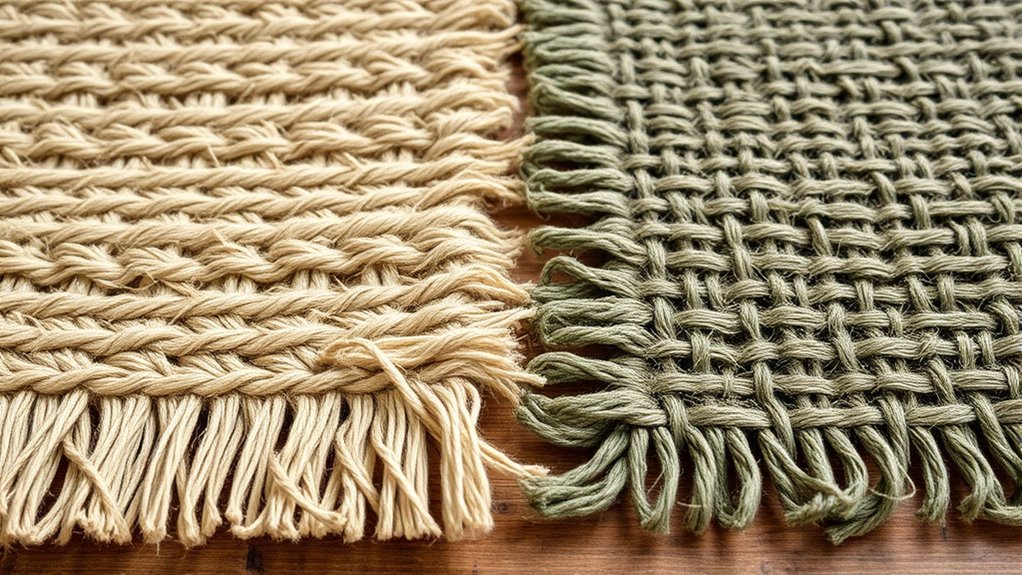
Hemp and nettle rugs are becoming more accessible and affordable as demand for sustainable home decor grows. You’ll find these fibers increasingly available through specialty eco-friendly stores and online marketplaces. Since hemp cultivation is widespread and requires less water and pesticides, its supply remains steady, helping keep costs down. Nettle fiber, though less common, is gaining traction as sustainable farmers expand production. As production techniques improve and demand increases, prices are likely to stabilize or decrease further. While initially more expensive than synthetic options, these natural fiber rugs are becoming more competitive in the market. Availability continues to grow, making it easier for you to choose eco-friendly rugs without breaking the bank. This trend supports your move toward sustainable, stylish home decor and is complemented by the nutritional advantages of green juice, which showcase the benefits of natural, eco-friendly choices.
Challenges and Limitations of Natural Fiber Rugs

While the growing availability of hemp and nettle rugs makes sustainable options more accessible, there are still challenges to contemplate. Natural fiber rugs can be delicate and less durable than synthetic ones, leading to concerns about longevity. You may also face difficulties in maintaining their appearance, as natural fibers are more susceptible to staining and wear. Additionally, limited color options and inconsistent textures can hinder your design choices, causing frustration if you seek a specific aesthetic. Moreover, remote hackathons can be a valuable platform for exploring innovative solutions to these durability and maintenance challenges, fostering collaboration across diverse teams.
Creative Ways to Incorporate Hemp and Nettle Into Home Decor
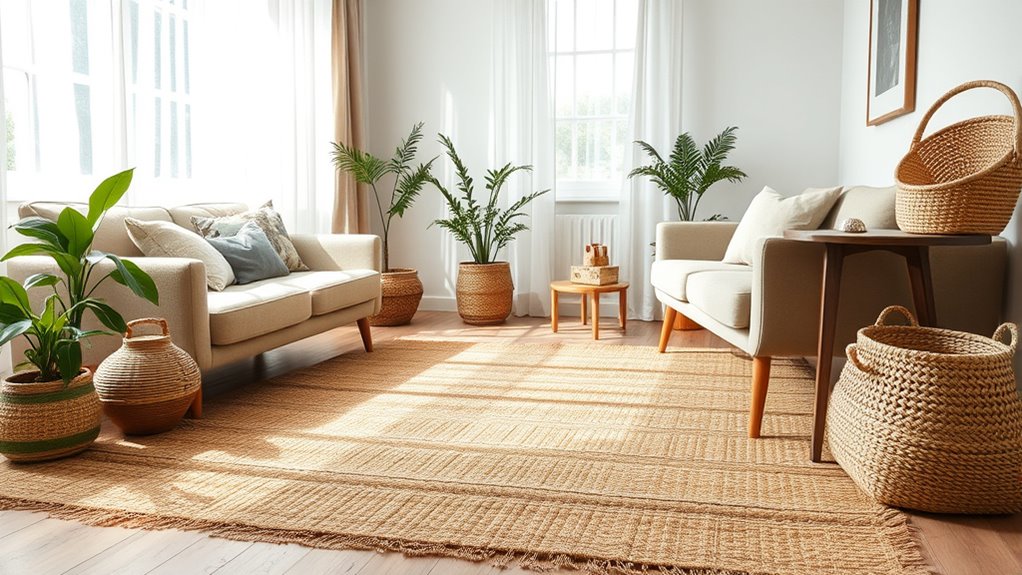
Incorporating hemp and nettle into your home decor offers a fresh, eco-friendly way to add texture and natural beauty to your space. You can use hemp and nettle fibers for creating unique wall hangings, upholstery, or pillow covers that bring earthy tones and tactile interest. These fibers work well in mixed media art or woven baskets, adding a sustainable touch to everyday items. Experiment with blending hemp or nettle in macramé plant hangers or table runners for a rustic yet modern look. Below is a visual guide to ideas:
| Decor Idea | Material/Technique |
|---|---|
| Wall Hangings | Hemp or nettle fibers, weaving |
| Upholstery | Hemp fabric furniture covers |
| Throw Pillows | Nettle-infused fabric |
| Macramé Plant Hangers | Hemp cord, knotting techniques |
| Table Runners | Nettle fiber weaving |
Future Trends in Sustainable Rug Materials

As sustainability continues to shape consumer preferences, the future of rug materials is poised for innovative advancements. Expect eco-friendly fibers to become more accessible, affordable, and stylish, transforming your home into a haven of green living. You’ll see developments like:
Sustainable rug innovations will make eco-friendly, stylish options more accessible and durable for your home.
- Bio-based and recycled materials that reduce waste and carbon footprints, making your decor more sustainable.
- Advanced manufacturing techniques that enhance durability while minimizing environmental impact, so your rugs last longer.
- Smart textiles integrating renewable fibers with modern technology, creating functional, beautiful pieces that align with your eco-conscious values.
These trends mean you can enjoy stunning, sustainable rugs that not only elevate your decor but also contribute positively to the planet’s health. The future of rug materials is brighter—and greener—than ever.
Frequently Asked Questions
Are Hemp and Nettle Rugs Suitable for Allergy Sufferers?
If you’re concerned about allergies, hemp and nettle rugs can be good options because they’re natural and often hypoallergenic. You’re less likely to experience irritation since these fibers resist mold, dust mites, and bacteria. However, it’s important to verify the rug is kept clean and free from dust. Regular vacuuming and airing out can help maintain a healthy environment, making these materials suitable for allergy sufferers.
How Do Hemp and Nettle Fibers Compare to Synthetic Alternatives Environmentally?
When comparing hemp and nettle fibers to synthetic alternatives, you’ll find they’re much more eco-friendly. You avoid plastic pollution and reduce reliance on fossil fuels, since hemp and nettle grow quickly with minimal water and pesticides. Synthetic fibers often shed microplastics and take centuries to decompose, while natural fibers break down faster and have a lower carbon footprint. Choosing hemp or nettle rugs helps you support sustainability and protect the environment.
Can Hemp and Nettle Rugs Be Recycled or Composted at End-Of-Life?
Ever wonder what happens when your hemp or nettle rug reaches the end of its life? You might be surprised—these natural fibers can often be composted, breaking down into nutrient-rich soil. Unlike synthetic rugs, which may linger in landfills, hemp and nettle rugs offer a sustainable end-of-life option, especially if free of synthetic treatments. So, yes, you can recycle or compost them, making your eco-conscious choice even greener.
What Certifications Ensure the Sustainability of Hemp and Nettle Rug Materials?
When you choose hemp or nettle rugs, you want to guarantee they’re truly sustainable. Look for certifications like GOTS (Global Organic Textile Standard) and OEKO-TEX Standard 100, which verify eco-friendly farming and safe production processes. These certifications guarantee that the materials are organic, free from harmful chemicals, and produced sustainably. By checking for these labels, you can confidently select rugs that align with your eco-conscious values and support sustainable practices.
How Do Climate Conditions Affect the Production of Hemp and Nettle Fibers?
Oh, the joys of climate! You see, if you want your hemp and nettle fibers to thrive, you better pray for just the right weather. Too much rain, and your crops rot; too little, and they wither away. You’ll need warm temperatures, adequate sunlight, and steady humidity. Basically, Mother Nature’s mood swings decide whether your fibers grow strong or go on strike—climate’s little way of keeping you on your toes.
Conclusion
Think of choosing hemp and nettle rugs as planting seeds for a greener future. With each step you take on these fibers, you nurture sustainability and resilience, like a gardener tending to a thriving, eco-friendly garden. Your choice transforms your space into a sanctuary that supports the planet. Embrace these natural materials, and you become part of a larger story—where small actions bloom into lasting change for generations to come.


